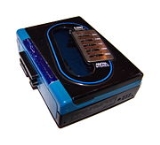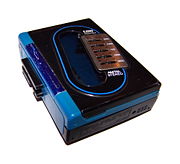
Portable audio player
Encyclopedia
A portable audio player is a personal mobile device that allows the user to listen to recorded audio while mobile. Sometimes a distinction is made between a portable player, battery-powered and with one or more small loudspeaker
s, and a personal player, listened to with earphones.
and Nagra
. Lower-priced units became available later. In the mid-1960s Philips
introduced the battery-operated compact cassette
recorder, originally used for recording speech. At about the same time the 8-track
player was introduced. It was very successful at the time, though bulky and inconvenient to use. There was an annoying pause at the end of each track as the program changed.
The compact cassette, although physically much smaller than the 8-track cartridge, became capable of good sound quality as the technology developed, and longer cassette tapes became available. Cassette deck
s (not portable) were introduced for home use, and this encouraged the production of pre-recorded music cassettes.
 The first truly personal cassette player, the Sony Walkman, was introduced in 1979 and sold very well. It was much smaller than an 8-track player or the earlier cassette recorders, and was listened to with stereophonic headphones, unlike previous equipment which used small loudspeakers. Unlike small loudspeakers, headphones were capable of very good sound quality. All previous compact cassette devices could record as well as play back; Walkmans and similar devices often had no recording facility, but took advantage of the pre-recorded cassettes now widely available.
The first truly personal cassette player, the Sony Walkman, was introduced in 1979 and sold very well. It was much smaller than an 8-track player or the earlier cassette recorders, and was listened to with stereophonic headphones, unlike previous equipment which used small loudspeakers. Unlike small loudspeakers, headphones were capable of very good sound quality. All previous compact cassette devices could record as well as play back; Walkmans and similar devices often had no recording facility, but took advantage of the pre-recorded cassettes now widely available.
and CDRW media either copied from a pressed CD or containing MP3 and similar files.
or hard disk
storage started to be available (The Rio PMP300
from Diamond Multimedia is widely considered to be the first mass market DAP). Files are usually compressed using lossy compression; this reduces file size at the cost of some loss of quality. The trade-off
between degree of compression and file size can be varied, although this is not an option for existing compressed files. The advantage of solid-state DAPs over hard disks and CDs is resistance to vibration, small size and weight, and low battery usage. Early solid-state DAPs had capacities of a few tens of kilobytes; capacities of many gigabytes are available.
Loudspeaker
A loudspeaker is an electroacoustic transducer that produces sound in response to an electrical audio signal input. Non-electrical loudspeakers were developed as accessories to telephone systems, but electronic amplification by vacuum tube made loudspeakers more generally useful...
s, and a personal player, listened to with earphones.
History
Portable battery-operated reel-to-reel tape recorders were introduced in the 1950s, initially tending to be high-priced units for reporters, produced by UherUher (brand)
Uher is a German brand of electronic equipment currently owned and licensed by Assmann Electronics of Bad Homburg.The manufacturer, Uher Werke was based in Munich, Germany, and is probably best-known for its former range of portable reel-to-reel tape recorders which were once widely used by...
and Nagra
Nagra
Nagra is the trademark referring to any of the series of mostly battery-operated portable professional audio recorders produced by Kudelski SA, based in Cheseaux-sur-Lausanne, Switzerland....
. Lower-priced units became available later. In the mid-1960s Philips
Philips
Koninklijke Philips Electronics N.V. , more commonly known as Philips, is a multinational Dutch electronics company....
introduced the battery-operated compact cassette
Compact Cassette
The Compact Cassette, often referred to as audio cassette, cassette tape, cassette, or simply tape, is a magnetic tape sound recording format. It was designed originally for dictation, but improvements in fidelity led the Compact Cassette to supplant the Stereo 8-track cartridge and reel-to-reel...
recorder, originally used for recording speech. At about the same time the 8-track
8-track cartridge
Stereo 8, commonly known as the eight-track cartridge, eight-track tape, or simply eight-track, is a magnetic tape sound recording technology. It was popular in the United States from the mid-1960s through the late 1970s, but was relatively unknown in many European countries...
player was introduced. It was very successful at the time, though bulky and inconvenient to use. There was an annoying pause at the end of each track as the program changed.
The compact cassette, although physically much smaller than the 8-track cartridge, became capable of good sound quality as the technology developed, and longer cassette tapes became available. Cassette deck
Cassette deck
A cassette deck is a type of tape recorder for playing or recording audio compact cassettes. A deck was formerly distinguished from a recorder as being part of a stereo component system, while a recorder had a self-contained power amplifier...
s (not portable) were introduced for home use, and this encouraged the production of pre-recorded music cassettes.

CD players
Early personal CD players can play commercial CDs; later models can play recordable CDRCDR
- Medicine and health care :*Clinical data repository, a medical database system designed to provide a realtime summary of a patient's condition*Clinical Dementia Rating...
and CDRW media either copied from a pressed CD or containing MP3 and similar files.
Digital players
In 1998, digital audio players (DAPs) based on flash memoryFlash memory
Flash memory is a non-volatile computer storage chip that can be electrically erased and reprogrammed. It was developed from EEPROM and must be erased in fairly large blocks before these can be rewritten with new data...
or hard disk
Hard disk
A hard disk drive is a non-volatile, random access digital magnetic data storage device. It features rotating rigid platters on a motor-driven spindle within a protective enclosure. Data is magnetically read from and written to the platter by read/write heads that float on a film of air above the...
storage started to be available (The Rio PMP300
Rio PMP300
The Rio PMP300 was a portable consumer MP3 digital audio player , and was produced by Diamond Multimedia. It was introduced September 15, 1998, and it shipped later that year.-Features:...
from Diamond Multimedia is widely considered to be the first mass market DAP). Files are usually compressed using lossy compression; this reduces file size at the cost of some loss of quality. The trade-off
Trade-off
A trade-off is a situation that involves losing one quality or aspect of something in return for gaining another quality or aspect...
between degree of compression and file size can be varied, although this is not an option for existing compressed files. The advantage of solid-state DAPs over hard disks and CDs is resistance to vibration, small size and weight, and low battery usage. Early solid-state DAPs had capacities of a few tens of kilobytes; capacities of many gigabytes are available.
Further reading
- Erlmann, Veit (ed.) Hearing Cultures. Essays on Sound, Listening, and Modernity, New York: Berg Publishers, 2004. Cf. Chapter 9: "Thinking About Sound, Proximity, and Distance in Western Experience: The Case of Odysseus's Walkman" by Michael Bull.

